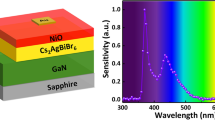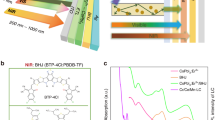Abstract
An ultraviolet (UV)-visible tunable photodetector based on ZnO nanorod arrays (NAs)/perovskite heterojunction solar cell structures is presented, in which the ZnO NAs are prepared using the hydrothermal method and annealed in different atmospheres. Based on solar cell structure perovskite photodetectors, it exhibited highly repeatable and stable photoelectric response characteristics. In addition, the devices with ZnO NAs annealed in a vacuum showed a high responsivity of about 1014 cm Hz1/2 W−1 in the visible region, whereas the devices with ZnO NAs annealed in air exhibited good detectivity in the UV region, especially at around 350 nm. Furthermore, when the annealing atmosphere of the ZnO nanorods was changed from vacuum to air, the dominant detection region of the photodetectors was altered from the visible to the ultraviolet region. These results enable potential applications of the ZnO NAs/perovskite photodetectors in ultraviolet and visible regions.
摘要
本文报道了一种基于ZnO纳米棒阵列/钙钛矿电池结构的紫外-可见可调的光电探测器, 其中ZnO纳米棒阵列采用水热法制备并在不同气氛下退火. 基于电池结构的钙钛矿光电探测器具有较好的光电响应重复性和稳定性. ZnO纳米棒阵列真空退火的器件在可见光区域达到了1014 Jones的响应度, 而ZnO纳米棒阵列在空气中退火的器件在紫外光区域, 尤其在365 nm处有较好的探测性能. 进一步研究发现, 通过不同氛围退火, 实现了紫外-可见可调的光电探测性能. 以上结果表明ZnO纳米棒阵列/钙钛矿光电探测器在紫外和可见光区域存在潜在应用.
Similar content being viewed by others
References
Kojima A, Teshima K, Shirai Y, et al. Organometal halide perovskites as visible-light sensitizers for photovoltaic cells. J Am Chem Soc, 2009, 131: 6050–6051
Zhou H, Chen Q, Li G, et al. Interface engineering of highly efficient perovskite solar cells. Science, 2014, 345: 542–546
Yang WS, Noh JH, Jeon NJ, et al. High-performance photovoltaic perovskite layers fabricated through intramolecular exchange. Science, 2015, 348: 1234–1237
Anaraki EH, Kermanpur A, Steier L, et al. Highly efficient and stable planar perovskite solar cells by solution-processed tin oxide. Energ Environ Sci, 2016, 9: 3128–3134
Fang Y, Huang J. Resolving weak light of sub-picowatt per square centimeter by hybrid perovskite photodetectors enabled by noise reduction. Adv Mater, 2015, 27: 2804–2810
Stranks SD, Eperon GE, Grancini G, et al. Electron-hole diffusion lengths exceeding 1 micrometer in an organometal trihalide perovskite absorber. Science, 2013, 342: 341–344
Xing G, Mathews N, Sun S, et al. Long-range balanced electronand hole-transport lengths in organic-inorganic CH3NH3PbI3. Science, 2013, 342: 344–347
Lee Y, Kwon J, Hwang E, et al. High-performance perovskite- graphene hybrid photodetector. Adv Mater, 2015, 27: 41–46
Liu C, Wang K, Yi C, et al. Ultrasensitive solution-processed perovskite hybrid photodetectors. J Mater Chem C, 2015, 3: 6600–6606
Saidaminov MI, Haque MA, Savoie M, et al. Perovskite photodetectors operating in both narrowband and broadband regimes. Adv Mater, 2016, 28: 8144–8149
Murali B, Saidaminov MI, Abdelhady AL, et al. Robust and air-stable sandwiched organo-lead halide perovskites for photodetector applications. J Mater Chem C, 2016, 4: 2545–2552
Guarnera S, Abate A, Zhang W, et al. Improving the long-term stability of perovskite solar cells with a porous Al2O3 buffer layer. J Phys Chem Lett, 2015, 6: 432–437
Son DY, Im JH, Kim HS, et al. 11% efficient perovskite solar cell based on ZnO nanorods: an effective charge collection system. J Phys Chem C, 2014, 118: 16567–16573
Kumar MH, Yantara N, Dharani S, et al. Flexible, low-temperature, solution processed ZnO-based perovskite solid state solar cells. Chem Commun, 2013, 49: 11089–11091
Zhou H, Zhu Y, Wang H, et al. Electroluminescence transition from visible- to ultraviolet-dominant mode in n-Mn0.04Zn0.96O/i-ZnGa2O4/n-GaN structurewith highly ultraviolet detection performance. IEEE Electron Device Lett, 2013, 34: 423–425
Xu Y, Liu T, Li Z, et al. Preparation and photovoltaic properties of perovskite solar cell based on ZnO nanorod arrays. Appl Surface Sci, 2016, 388: 89–96
Zhou H, Gui P, Yu Q, et al. Self-powered, visible-blind ultraviolet photodetector based on n-ZnO nanorods/i-MgO/p-GaN structure light-emitting diodes. J Mater Chem C, 2015, 3: 990–994
Lin Q, Armin A, Lyons DM, et al. Lownoise, IR-blind organohalide perovskite photodiodes for visible light detection and imaging. Adv Mater, 2015, 27: 2060–2064
Zhou H, Song Z, Tao P, et al. Self-powered, ultraviolet-visible perovskite photodetector based on TiO2 nanorods. RSC Adv, 2016, 6: 6205–6208
Yu J, Chen X, Wang Y, et al. A high-performance self-powered broadband photodetector based on aCH3NH3PbI3 perovskite/ZnO nanorod array heterostructure. J Mater Chem C, 2016, 4: 7302–7308
Dou L, Yang YM, You J, et al. Solution-processed hybrid perovskite photodetectors with high detectivity. Nat Commun, 2014, 5: 5404
Lee MM, Teuscher J, Miyasaka T, et al. Efficient hybrid solar cells based on meso-superstructured organometal halide perovskites. Science, 2012, 338: 643–647
Ke W, Fang G, Wan J, et al. Efficient hole-blocking layer-free planar halide perovskite thin-film solar cells. Nat Commun, 2015, 6: 6700
Hu X, Zhang X, Liang L, et al. High-performance flexible broadband photodetector based on organolead halide perovskite. Adv Funct Mater, 2014, 24: 7373–7380
Huo C, Cai B, Yuan Z, et al. Two-dimensional metal halide perovskites: theory, synthesis, and optoelectronics. Small Methods, 2017, 1: 1600018
Li X, Cao F, Yu D, et al. All inorganic halide perovskites nanosystem: synthesis, structural features, optical properties and optoelectronic applications. Small, 2017, 13: 1603996
Li X, Yu D, Chen J, et al. Constructing fast carrier tracks into flexible perovskite photodetectors to greatly improve responsivity. ACS Nano, 2017, 11: 2015–2023
Zhou H, Fang GJ, Zhu Y, et al. Flexible resistive switchingmemory based onMn0.20Zn0.80O/HfO2 bilayer structure. J PhysD-Appl Phys, 2011, 44: 445101
Wang J, Wang Z, Huang B, et al. Oxygen vacancy induced bandgap narrowing and enhanced visible light photocatalytic activity of ZnO. ACS Appl Mater Interfaces, 2012, 4: 4024–4030
Ji LW, Peng SM, Su YK, et al. Ultraviolet photodetectors based on selectively grown ZnO nanorod arrays. Appl Phys Lett, 2009, 94: 203106
Zhou H, Fang G, Liu N, et al. Ultraviolet photodetectors based on ZnO nanorods-seed layer effect and metal oxide modifying layer effect. Nanoscale Res Lett, 2011, 6: 147
Tam KH, Cheung CK, Leung YH, et al. Defects in ZnO nanorods prepared by a hydrothermal method. J Phys Chem B, 2006, 110: 20865–20871
Acknowledgments
This work is supported by the National Nature Science Foundation of China (51372075).
Author information
Authors and Affiliations
Corresponding authors
Additional information
Mengni Xue received her bachelor’s degree in Science fromWuhan Institute of Technology,Wuhan, China. She is currently a graduate student in the Faculty of Physics and Electronic Science, Hubei University, Wuhan, China. Her main research areas include photodetectors and photoelectric devices based on perovskite materials.
Hai Zhou received his MSc and PhD degrees in Microelectronics and Solid State Electronics from Wuhan University, Wuhan, China. He is currently an associate professor of Hubei Collaborative Innovation Center for Advanced Organic Chemical Materials, Hubei Key Laboratory of Ferroelectric and Dielectric Materials and Devices, the Faculty of Physics and Electronic Science, Hubei University, Wuhan, China. His main research areas include self-power photodetectors, ultraviolet LEDs devices, and photoelectric devices based on perovskite materials.
Hao Wang is a Chair Professor of the Faculty of Hubei University. He received his PhD degree from Huazhong University of Science and Technology in 1994. He is a visiting professor of the University of Cambridge and Aalto University. He has published more than 150 peer reviewed papers (such as Adv. EnergyMater., ACS Nano, Nano Energy) and held 18 patents. His research interests involve solar cells, fuel cells, non-volatile memory, photodetectors and magnetic nanostructures.
Rights and permissions
About this article
Cite this article
Xue, M., Zhou, H., Xu, Y. et al. High-performance ultraviolet-visible tunable perovskite photodetector based on solar cell structure. Sci. China Mater. 60, 407–414 (2017). https://doi.org/10.1007/s40843-017-9028-y
Received:
Accepted:
Published:
Issue Date:
DOI: https://doi.org/10.1007/s40843-017-9028-y




